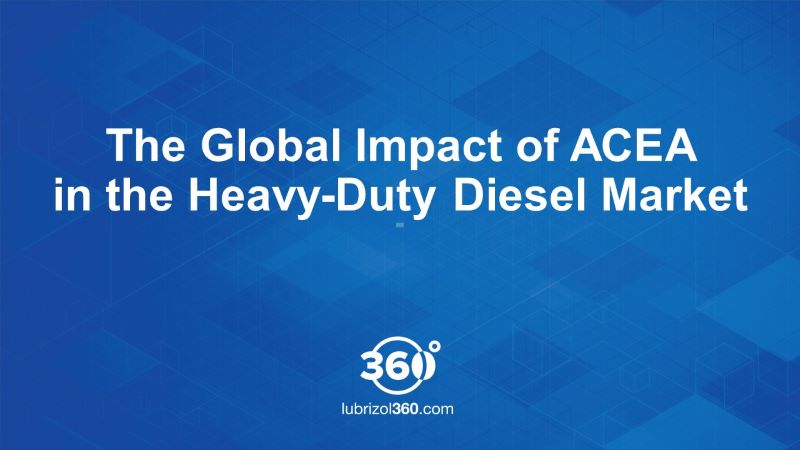Heavy-duty commercial vehicles are essential, keeping the wheels of industry turning around the globe. While approximately one in every five trucks, vans and buses produced globally is manufactured in the European Union (EU), they can be seen in operation across all inhabited continents. Many European commercial vehicle original equipment manufacturers (OEMs) have established global operations with regional manufacturing facilities, and this has a direct impact on the service-fill engine lubricant requirements in each region.
Since their introduction in 1996, the European Automobile Manufacturers’ Association (ACEA) Oil Sequences have prescribed the minimum quality level of service-fill oils demanded by ACEA members for use in their vehicles. Engine lubricants being approved to the relevant ACEA category provide fleet owners and operators with the reassurance that their engine lubricant meets the minimum quality levels for their vehicles, wherever in the world they are located. Lubrizol estimates that in Latin America alone, 50% of the commercial vehicle lubricants on the market align with an ACEA category of some kind.
Heavy-duty commercial engine hardware and aftertreatment requirements have evolved over time to support increased efficiency and to reduce emissions. As a result, the engine lubricant needs to provide continued protection in engines operating at higher temperatures and also plays a key role in prolonging the life of advanced aftertreatment devices. The lubricant is also tasked to provide this protection for longer as the periods between service intervals continue to expand. To ensure heavy-duty diesel engine lubricants continue to meet the latest demands from the ACEA members, the 2022 revisions to the ACEA Heavy-Duty Engine Oil Sequences incorporate performance changes together with both new and replacement tests.
The ACEA 2022 sequences take into account key trends happening in the vehicle parc. The upgraded 2022 oil sequences introduce two new categories, ACEA E8 (replacing ACEA E6) and ACEA E11 (replacing ACEA E9), both contain important new tests, including the Volvo T-13 oxidation test and Caterpillar Oil Aeration Test (COAT). ACEA 2022 also sees the introduction of the Daimler OM471 piston cleanliness test as a replacement for the OM501LA test in select categories; using engine hardware that is more representative of technology found in modern vehicles being manufactured today.
The upgrade to higher-performing engine lubricants has relevance across the globe. In China, the ACEA 2022 Oil Sequences will play an important part in enabling a successful implementation of the China VI emission standard with a focus on ACEA E8; reducing engine wear, reducing ash build-up and avoiding DPF blockages.
The ACEA E8 and ACEA E11 categories see increased limits in the existing OM646BIO test; a test which ensures the lubricant can perform effectively in the presence of biodiesel. Other industry baselines such as the widely used API categories do not include testing for biodiesel compatibility, making ACEA categories increasingly relevant outside of Europe. The increased levels of biodiesel content being adopted in countries including Thailand, Indonesia and Brazil make the OM646BIO test particularly relevant. By testing this key parameter, fleet operators can be reassured that the engine lubricant performs effectively in the presence of biodiesel, as well as in the other performance requirements demanded by the OEM.
In addition to the ACEA Heavy-Duty Diesel E Sequences two new ACEA F categories (ACEA F8 and ACEA F11) are currently under ongoing development. Both F categories focus on delivering enhanced fuel efficiency benefits versus ACEA E8 and ACEA E11 respectively as engine lubricants move to a lower (2.9-3.2 mPa.s) HTHS viscosity. ACEA F8 and F11 will be released in a future update to the Heavy-Duty Diesel Oil Sequences.
To meet the performance levels of the ACEA 2022 sequences, heavy-duty diesel engine lubricants must be correctly formulated to ensure the performance additives, performance polymers and base oils work in harmony with the engine hardware and aftertreatment systems.
Our View
With millions of ACEA members’ heavy-duty commercial vehicles in use across the world, the global relevance of the ACEA Engine Oil Sequences has never been greater.
The ACEA 2022 Heavy-Duty Engine Oil Sequences play an important part in the ongoing drive to improve lubricant performance and provide the new baseline for the next generation of OEM specifications.
Surpassing, rather than just meeting, the rigorous performance demands of the upgrade enables oil marketers to deliver higher-performing engine lubricants that exceed the new specifications, providing additional protection and performance benefits to heavy-duty commercial vehicles around the world.
For more information on the Global Impact of ACEA in the Heavy-Duty Diesel Market, watch our video above, see our additional ACEA On-Highway information or contact your Lubrizol representative.










